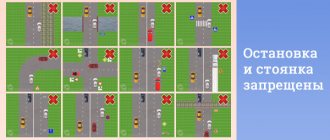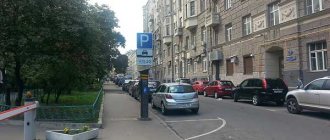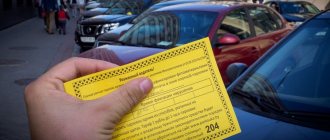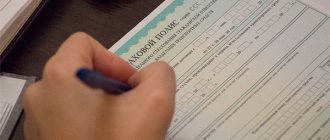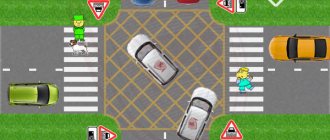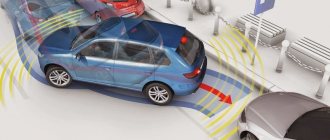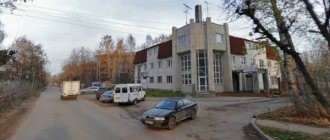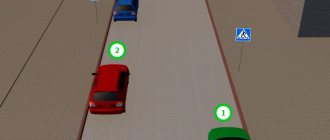Thorough knowledge of traffic rules is the responsibility of any car owner. The set of rules fully regulates the process of vehicle movement on the roads, thereby reducing the risk of accidents. In particular, the traffic rules quite clearly explain exactly where a stop should be made at an intersection. In this case, the driver’s actions will depend on the type of road intersection and the accompanying signs. At the same time, for non-compliance with traffic rules, administrative liability and punishment in the form of a fine are provided.
What is a crossroads
The essence of the concept of “intersection” is reflected in clause 1.2 of the code of traffic rules, regulated by Decree of the Government of the Russian Federation No. 1090 (dated October 23, 1993). This formulation denotes a specific place where roads branch, intersect or adjoin each other at the same level. A similar area is limited mentally by non-existent lines. The latter connect the rounded beginnings of roads located opposite each other, which are most distant from the center point of the intersection.
The concept does not include:
- departures from adjacent territorial areas;
- multi-level road junctions with bridges and overpasses.
In the above sections, the rules for moving through intersections, as well as stopping in front of them, do not apply.
Features of stopping before crossing roads: tips for the driver
The rules for stopping before crossing roads are indicated in clause 6, as well as clause 13 of the traffic rules. In this case, the driver’s actions depend on the type of intersection. There are 2 types in total - regulated and unregulated.
At the same time, despite a fairly clear statement of the requirements for traffic on the roadway, car owners often encounter difficulties. Especially stopping before an intersection and generally moving around it is difficult for novice drivers.
In order not to break the rules and successfully drive through such a section, while slowing down in the right place, you will need to act as follows:
- determine the travel option - entering or exiting the intersection;
- change lanes;
- find out the type of intersection you are crossing - from here it will become clear where exactly you should stop;
- follow the signs placed and depicted on the road surface.
Carrying out the listed actions, and in general, knowledge of traffic regulations will help you comply with safety standards and prevent emergency situations.
Fine for driving on the side of the road
For driving on the side of the road or crossing in an organized convoy, the Code of Administrative Offenses provides for punishment in the form of a fine in the amount of one thousand five hundred rubles.
Fine for driving on the wrong side of the road
In a situation where the driver pulls onto the side of the road from the left side, except for the cases indicated above, he violates the traffic rules twice:
- driving onto the side of oncoming traffic;
- driving into the oncoming lane.
For such a violation of traffic rules, the Code of Administrative Offenses provides for a fine of five thousand rubles or deprivation of a driver’s license for a period of four to six months.
Fines for similar offenses
There is such a violation as driving on a pedestrian zone or bicycle path. For such a violation, the Code of Administrative Offenses establishes punishment in the form of a fine in the amount of one thousand five hundred rubles.
Rules for stopping at a signalized intersection
According to clause 13.3 of the Rules, a controlled intersection is understood as an area where the priority of movement is determined by a traffic light or by the direction of a traffic controller. Accordingly, the stop in this case is carried out by a prohibiting command or signal.
When choosing a place, you should be guided by clause 6.13 of the traffic rules. The rule states that a stop line at a traffic light means you need to brake strictly in front of it. The corresponding sign is indicated by number 6.16. In practice, it looks like a sign with an image of the word “STOP” .
Options for placing a sign on the road surface:
- to the right of the roadway (usually at the traffic light itself);
- over the road;
- over each traffic lane.
Also, the stop line can take the form of a marking. In this case, you need to brake directly in front of it.
If there are both signs on the road, then you should stop in front of the “STOP” sign. This is due to the fact that road signs take precedence over markings.
As for where and how to stop at a traffic light at a controlled intersection, if there are no additional signs, then in such a situation you need to brake in front of the roadway. In this case, you must not interfere with pedestrian traffic.
In practice, there are 2 options for stopping if there is no sign 6.16:
- in front of a traffic light, if there is no crossing for pedestrians;
- before the zebra crossing, if there is one.
If there are no pedestrian markings, but people are crossing the area, then you need to stop immediately in front of it. It is forbidden to interfere with citizens and drive past traffic lights.
Additionally, it is worth considering clause 13.7 of the Rules. It states that a car owner who has entered a road intersection when there is a traffic signal allowing such action must leave the area in the chosen direction. Movement in this case does not depend on the commands of the traffic light located at the exit from this zone. But if there are stop lines on the site located in front of traffic lights along the vector of the vehicle’s movement, then its owner is obliged to act in accordance with the commands of each signaling device.
Dear reader! Didn't receive an answer to your question? Our expert lawyers work for you. It's absolutely free!
- Moscow ext 152
- St. Petersburg ext 152
- All regions ext 132 (Toll free)
What is a shoulder and the consequences of driving on it?
According to the traffic rules, the shoulder is the part of the road adjacent to the roadway. It is distinguished by a different type of road surface and is indicated by special markings.
By driving through traffic jams on the side of the road and joining a line, the driver interferes with the movement of other motorists and in fact only increases the congestion. This creates an obstacle to the normal movement of those who are allowed to move along the side of the road by the rules: pedestrians, cyclists, horse-drawn carts, and others. Dust often rises from the side of the road and flies onto other road users. Needless to say, driving along the side of the road often leads to minor and even major traffic accidents.
In this regard, there was a need for appropriate punishment for violation of the rules. And now specifically and point by point about what punishment motorists face for driving on the side of the road and what fine they will have to pay in case of a recorded offense.
Stopping at an unregulated intersection
If there is no traffic controller or traffic light at the intersection of roads, and if it is turned off or flashing yellow, then the area is considered unregulated.
The variety includes 2 more subtypes:
- Equivalent intersection. Signs: there is no traffic controller or traffic light, intersecting roads have the same surface, no priority signs. A site is recognized as equivalent only if the specified conditions are simultaneously met. Additionally, sign 1.6 may be placed as a designation.
- Uneven intersection. In this case, one of the intersecting roads must be the main one. It is indicated by signs 2.1, 5.1, 2.3.1–2.3.7. Or it can be a road with a hard surface (asphalt, stone), while secondary areas should be covered with soil (sand, earth). The road is also considered the main one in relation to exits from the adjacent territory.
Stopping in front of such areas is regulated by the presence of sign 2.5. The sign “Driving without stopping is prohibited” is usually placed at an unregulated intersection of unequal roads.
2.5 indicates the prohibition of movement without stopping in front of the stop line or in front of the edge of the roadway. In this case, the car owner is obliged to give way to cars moving along the road part he is crossing, or along the main road, if sign 8.13 is present.
The choice of where to brake a car if there is a 2.5 indicator should be as follows:
- in front of the stop line, if there is one;
- before crossing highways if the line is not marked.
In fact, it turns out that stopping at an unregulated intersection of roads is mandatory only if there are signs of inequality, and there is a sign 2.5 on the section.
Is stopping at a road intersection allowed?
If you need to stop on intersecting road sections, the main thing is not to go to the intersection itself, or to the pedestrian zebra crossing. This is prohibited by clause 12.4 of the traffic rules. You should brake more than 5 m before the road you are crossing.
The exception includes the sides opposite the side passages of three-way intersections. In particular, if they have a dividing strip or a continuous marking line.
According to clause 12.5 of the Rules, parking of vehicles at road intersections is also not allowed. In this case, a forced stop falls into the category of exceptions. For example, due to a malfunction of the car, unfavorable condition of the driver or passenger, or when an obstacle appears on the roadway.
However, stopping behind the intersection is permitted. After leaving the intersection, parking the car is allowed in accordance with the general requirements and parking rules (clause 12 of the traffic rules).
What are the best places not to choose to stop?
In places where it is forbidden to leave a car even for a short time, parking is also prohibited. Therefore, it is worth familiarizing yourself with their list:
- Tram tracks and the area around them, if the driver’s actions lead to interference with the movement of rail transport. A controversial issue is the situation when a driver has to freeze on the rails due to crossing an intersection. In this case, it is permissible to stop on the tram tracks, but you should not interfere with the passage of rail transport. Traffic police officers recommend not to stop when crossing the rails under any circumstances.
- When driving on a bridge, overpass or overpass, you can park for a short stop if the structure has more than 3 lanes for traffic.
- Do not park in any situation while driving through a tunnel, under an overpass or under an overpass.
- When driving through unregulated roads and intersections, you need to pay attention to the markings and distance. It is prohibited to stop near the dividing strip marked with a solid line or the opposite edge of the roadway. The distance to these objects should be more than 3 meters.
- If visibility for the driver is less than 100 meters, stopping is also dangerous. Do not place the car on sharp turns or profile bends in the road.
- You must maintain a gap of more than 5 meters from the intersection of roadways to stop. It is controversial to say that leaving the yard is not considered a full-fledged intersection. One thing is absolutely certain - if you leave your car near such an exit, it will become a hindrance for other road users.
- A fifteen-meter zone around a public transport stop or near a taxi rank is also not suitable for parking.
- When choosing a place to stop, you need to focus on the location of signs and traffic lights. For the most part, drivers of heavy vehicles should pay close attention to this point. Those driving a passenger car need to remember that they should not interfere with pedestrians.
- A vehicle must not occupy a designated bicycle lane or path.
- At intersections, you need to pay attention to the location of the crossings - you need to maintain a distance of more than 5 meters from the zebra crossing.
To become familiar with the places where stopping is prohibited, you must carefully study paragraph 12.4.

